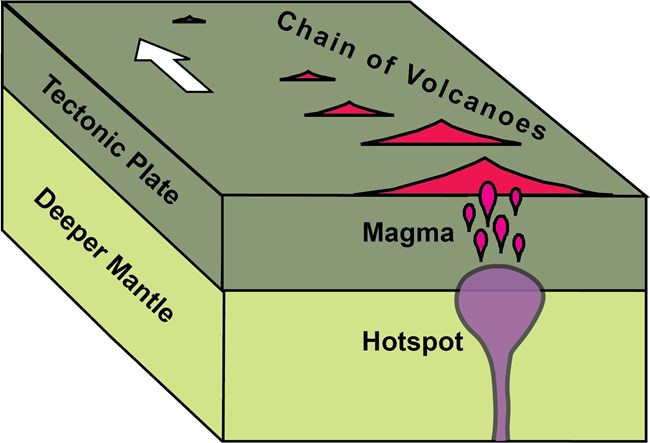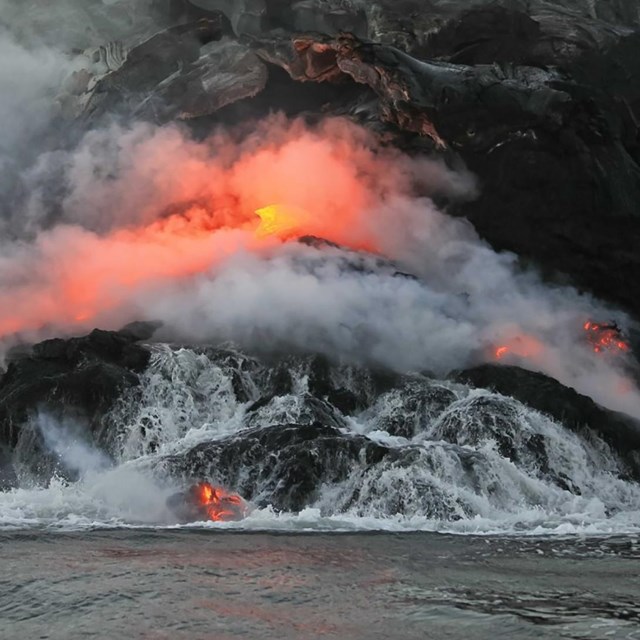
NPS photo.
Introduction
Some chains of volcanoes lie within the interiors of tectonic plates rather than along the edges. The volcanoes are progressively older away from the largest and most active volcano. A hotspot is a large plume of hot mantle material rising from deep within the Earth. A line of volcanoes develops as a plate moves over a hotspot, much as a line of melted wax forms as a sheet of waxed paper is moved slowly over a burning candle. Several National Park Service sites lie above hotspots, or within volcanic regions formed as plates moved over a hotspot.
Hot Spot Track


A chain of volcanoes (hotspot track) forms as a tectonic plate moves over a plume of hot mantle material (hotspot) rising from deep within the Earth.

The landscapes of National Park Service sites along hotspot tracks differ depending on if the plate riding over the hotspot is capped by thin oceanic or thick continental crust. Oceanic Hotspots: Sites in Hawaii and American Samoa lie along chains of volcanic islands that get progressively older away from hotspots. Continental Hotspot: Yellowstone National Park contains the youngest of a chain of explosive super volcanoes that stretch across the Snake River Plain of Idaho to the Columbia Plateau in Oregon and Washington, where the Yellowstone Hotspot surfaced 17 million years ago.
NPS Landscapes Developed at Hotspots
Two prominent hotspot tracks appear on a map of the 50 United States, one involving a plate with thin oceanic crust (Hawaii), and one with thicker continental crust (Yellowstone).

Modified from “Parks and Plates: The Geology of our National Parks, Monuments and Seashores,” by Robert J. Lillie, New York, W. W. Norton and Company, 298 pp., 2005, www.amazon.com/dp/0134905172.

NPS photo.
The Hawaiian Islands are broad and high at the southeast, becoming smaller and lower to the northwest. Two national parks, Haleakala on Maui and Hawaii Volcanoes on the Big Island called Hawaii, represent different stages of passage of the Pacific Plate over the Hawaiian Hotspot. National Park of American Samoa reveals another volcanic island chain formed as the Pacific Plate moves over a different hotspot.

Photo courtesy of Robert J. Lillie.
On the North American continent the Snake River Plain of southern Idaho connects the Columbia Plateau region of southeastern Washington and northeastern Oregon with Yellowstone National Park in the northwest corner of Wyoming. Extensive basalt lava flows at John Day Fossil Beds National Monument in Oregon represent the initial surfacing of the Yellowstone Hotspot. Progressively younger volcanic rocks across southern Idaho record the west-southwest movement of the North American continent across the hotspot. The spectacular geysers, hot springs and other hydrothermal features in Yellowstone National Park illustrate that the hotspot is still alive and well.
Tectonic Settings—Hotspots
Figures Used
Related Links
Site Index & Credits
Plate Tectonics and Our National Parks
- Plate Tectonics—The Unifying Theory of Geology
- Inner Earth Model
- Evidence of Plate Motions
- Types of Plate Boundaries
- Tectonic Settings of NPS Sites—Master List
Teaching Resources—Plate Tectonics
Photos and Multimedia—Plate Tectonics
Geological Monitoring—Plate Tectonics
Plate Tectonics and Our National Parks (2020)
-
Text and Illustrations by Robert J. Lillie, Emeritus Professor of Geosciences, Oregon State University [E-mail]
-
Produced under a Cooperative Agreement for earth science education between the National Park Service's Geologic Resources Division and the American Geosciences Institute.
Last updated: February 11, 2020


